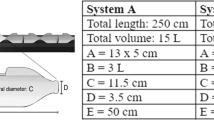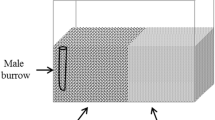Abstract
We investigated behavioural responses (locomotor activity and substrate selection) of the amphipod Talitrus saltator after laboratory exposure to different concentrations of Hg, Cu and Cd. Locomotor activity, measured with a microwave radar device, was assessed in animals exposed to contaminated sand and in sandhoppers previously kept for 48 h in contaminated seawater and tested in clean sand. The contents of Hg, Cu and Cd in T. saltator tissues were measured at the end of pre-exposure to contaminated seawater and after 7 days of exposure to contaminated sand. Substrate selection tests were carried out in a binary choice arena. Tests in contaminated sand showed that sandhopper locomotor activity varied in a dose-dependent manner in the presence of Cu and Hg (at lower Hg concentration they were more active during daytime) but did not show significant changes in Cd-exposed animals except for disappearance of the typical circadian activity pattern. Pre-exposure to trace metals in seawater induced a significant decrease of movements for all metals, although the effects varied according to the toxicity of the metal. Trace metals analyses showed that tissue concentrations of Hg, Cu and Cd were related to their concentrations in the test medium. Substrate selection tests showed avoidance of contaminated sand only when sandhoppers were tested in the presence of both concentrations of Hg and at the higher concentration of Cu. In conclusion, locomotor activity and avoidance behaviour of T. saltator could be used as behavioural biomarkers of trace metals exposure.




Similar content being viewed by others
References
Amiard-Triquet C (2009) Behavioral disturbances: The missing link between sub-organismal and supra-organismal responses to stress? Prospects based on aquatic research. Hum Ecol Risk Assess 15(1):87–110
Bat L, Raffaelli D, Marr IL (1998) The accumulation of copper, zinc and cadmium by the amphipod Corophium volutator (Pallas). J Exp Mar Biol Ecol 223:167–184
Benson JA, Lewis RD (1976) An analysis of the activity rhythm of the sand beach amphipod Talorchestia quoyana. J Comp Physiol 105:339–352
Boyd WA, Williams PL (2003) The availability of metals to the nematode Caenorhabditis elegans: toxicity based on total concentrations in soil and extracted fractions. Environ Toxicol Chem 22:1100–1106
Branch G, Branch M (1981) The living shores of Southern Africa. G Struik Publication, Cape Town
Bregazzi PK, Naylor E (1972) The locomotor activity rhythm of Talitrus saltator (Montagu) (Crustacea, Amphipoda). J Exp Biol 57:375–391
De Lange HJ, Noordoven W, Murk AJ, Lurling M, Peeters ET (2006) Behavioral response of Gammarus pulex (Crustacea, Amphipoda) to low concentrations of pharmaceuticals. Aquat Toxicol 78:209–216
Dell’Omo G (2002) Behavioural ecotoxicology. Wiley, Chichester
Ercolini A (1958) Sul ciclo normale di attività di alcuni talitridi litorali. Boll Ist Mus Zool Univ Torino 6:163–170
Erdem C, Maedows PS (1980) The influence of mercury on the burrowing behaviour of Corophium volutator. Mar Biol 56:233–237
Eriksson Wiklund A-K, Börjesson T, Wiklund SJ (2006) Avoidance response of sediment living amphipods to zinc pyrithione as a measure of sediment toxicity. Mar Pollut Bull 52:96–99
Forbes VE, Palmqvist A, Bach L (2006) The use and misuse of biomarkers in ecotoxicology. Environ Toxicol Chem 25:272–280
Geppetti L, Tongiorgi P (1967) Nocturnal migration of Talitrus saltator (Montagu) (Crustacea, Amphipoda). Monit Zool Ital (NS) 1:37–40
Gerhardt A (1999) Recent trends in online biomonitoring for water quality control. In: Gerhardt A (ed) Biomonitoring of polluted water. Reviews on actual topics, vol 9. Environmental Research Forum, TTP, Switzerland, pp 95–118
Griffiths CL, Stenton-Dozey JME, Koop K (1983) Kelp wrack and the flow of energy through a sandy beach ecosystem. In: McLachlan A, Erasmus T (eds) Sandy beaches as ecosystems. W. Junk Publishers, The Hague, pp 547–556
Hellou J (2011) Behavioural ecotoxicology, an “early warning” signal to assess environmental quality. Environ Sci Pollut Res 18:1–11
Kirkpatrick AJ, Gerhardt A, Dick JTA, McKenna M, Berges JA (2006) Use of the multispecies freshwater biomonitor to assess behavioural changes of Corophium volutator (Pallas, 1766) (Crustacea, Amphipoda) in response to toxicant exposure in sediment. Ecotoxicol Environ Saf 64:298–303
Marsden ID, Rainbow PS (2004) Does the accumulation of trace metals in crustaceans affect their ecology—the amphipods example? J Exp Biol Ecol 300:373–408
McLachlan A, Brown AC (2006) Ecology of sandy shores. Elsevier, Amsterdam
McLaughlin MJ, Hamon RE, Parker DR, Pierzynski GM, Smolders E, Thornton I, Welp G (2002) Test methods to determine hazards of sparingly soluble metal compounds in soils. In: Fairbrother A, Glazebrook PW, Tarazona JV, Van Straalen NM (eds) Soil chemistry. Society of Environmental Toxicology and Chemistry (SETAC), Pensacola
Mills CH, Shukla DH, Compton GJ (2006) Development of a new low cost high sensitivity system for behavioural ecotoxicity testing. Aquat Toxicol 77:197–201
Morritt D (1988) The ecophysiology of selected Talitroidean amphipods (Crustacea: Amphipoda: Talitridae). PhD Thesis, University of Bristol, Bristol, England, pp 1–209
Mouneyrac C, Amiard JC, Amiard-Triquet C, Cottier A, Rainbow PS, Smith BD (2002) Partitioning of accumulated trace metals in the talitrid amphipod crustacean Orchestia gammarellus: a cautionary tale on the use of metallothionein-like proteins as biomarkers. Aquat Toxicol 57:225–242
Naylor E (2010) Chronobiology of marine organisms. Cambridge University Press, Cambridge
Oakden JM, Oliver JS, Flegal AR (1984) EDTA chelation and zinc antagonism with cadmium in sediment: effects on the behaviour and mortality of two infaunal amphipods. Mar Biol 84:125–130
Pasquali V, Renzi P (2005) On the use of microwave radar devices in chronobiology studies: an application with Periplaneta americana. Behav Res Methods 37:522–527
Refinetti R (2004) Non-stationary time series and the robustness of circadian rhythms. J Theor Biol 227:571–581
Scapini F, Chelazzi I, Colombini I, Fallaci M (1992) Surface activity, zonation and migration of Talitrus saltator on a Mediterranean beach. Mar Biol 112:573–581
Siegel S, Castellan NJ Jr (1989) Nonparametric statistics for the behavioural sciences, 2nd edn. McGraw Hill, New York
Sokolove PG, Bushell WN (1978) The chi square periodogram: its utility for analysis of circadian rhythms. J Theor Biol 72:131–160
Ugolini A (2003) Activity rhythms and orientation in sandhopper (Crustacea, Amphipoda). Front Biosci 8:722–732
Ugolini A, Felicioni S, Ruffo S, Cipriani L (1995) Distribution of Talorchestia ugolinii and other sandhoppers in Corsica. Boll Zool 62:291–296
Ugolini A, Borghini F, Calosi P, Bazzicalupo M, Chelazzi G, Focardi S (2004) Mediterranean Talitrus saltator (Crustacea, Amphipoda) as a biomonitor of heavy metals contamination. Mar Pollut Bull 48:526–532
Ugolini A, Somigli S, Pasquali R, Renzi P (2007) Locomotor activity and sun compass orientation in the sandhopper Talitrus saltator are related. J Comp Physiol A 193:1259–1263
Ungherese G, Ugolini A (2009) Sandhopper solar orientation as a behavioural biomarker of trace metals contamination. Environ Pollut 157:1360–1364
Ungherese G, Baroni D, Focardi S, Ugolini A (2010a) Trace metals contamination of Tuscan and eastern Corsican supralittoral zones: the sandhopper Talitrus saltator (Montagu) as a biomonitor. Ecotoxicol Environ Saf 73:1919–1924
Ungherese G, Mengoni A, Somigli S, Baroni D, Focardi S, Ugolini A (2010b) Relationship between heavy metals pollution and genetic diversity in Mediterranean populations of the sandhopper Talitrus saltator (Montagu) (Crustacea, Amphipoda). Environ Pollut 158:1638–1643
Ungherese G, Baroni D, Bruni P, Focardi SE, Ugolini A (2011) Metallothionein induction in the sandhopper Talitrus saltator (Montagu) (Crustacea, Amphipoda). Water Air Soil Pollut. doi:10.1007/s11270-010-0711-7
Wallace WG, Estephan A (2004) Differential susceptibility of horizontal and vertical swimming activity to cadmium in a gammaridean amphipod (Gammarus lawrencianus). Aquat Toxicol 69:289–297
Weeks JM, Rainbow PS (1991) The uptake and accumulation of zinc and copper from solution by two species of talitrid amphipods (Crustacea). J Mar Biol Assoc UK 45:811–826
Weeks JM, Rainbow PS (1993) The relative importance of food and seawater as sources of copper and zinc to talitrid amphipods (Crustacea; Amphipoda; Talitridae). J Appl Ecol 30:722–735
Wildish DJ (1970) Locomotor activity rhythms in some littoral Orchestia (Crustacea; Amphipoda). Mar Biol 50:241–252
Williams JA (1980a) Environmental influence on the locomotor activity rhythm of Talitrus saltator (Crustacea; Amphipoda). Mar Biol 57:7–16
Williams JA (1980b) The effect of dusk and dawn on the locomotor activity rhythm of Talitrus saltator (Crustacea; Amphipoda). J Exp Mar Biol Ecol 42:285–297
Acknowledgments
The research was financially supported by Fondazione Cassa di Risparmi di Livorno (Livorno) (2010 Settore Arte-Educazione-Salute-Ricerca Scientifica). Thanks are due to the Ente Parco Regionale di Migliarino, San Rossore, Massaciuccoli (Pisa) for authorizing the samplings.
Author information
Authors and Affiliations
Corresponding author
Rights and permissions
About this article
Cite this article
Ugolini, A., Pasquali, V., Baroni, D. et al. Behavioural responses of the supralittoral amphipod Talitrus saltator (Montagu) to trace metals contamination. Ecotoxicology 21, 139–147 (2012). https://doi.org/10.1007/s10646-011-0773-3
Accepted:
Published:
Issue Date:
DOI: https://doi.org/10.1007/s10646-011-0773-3




